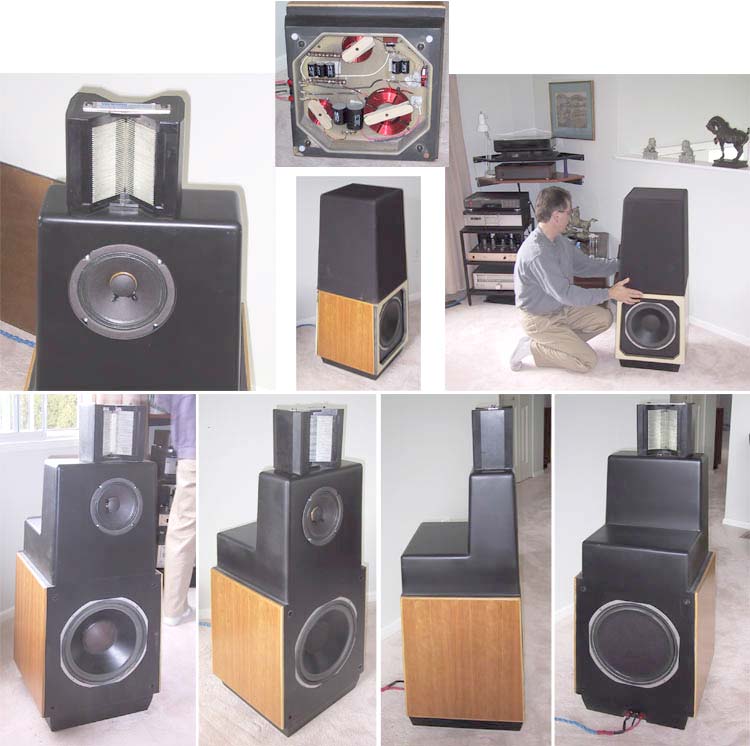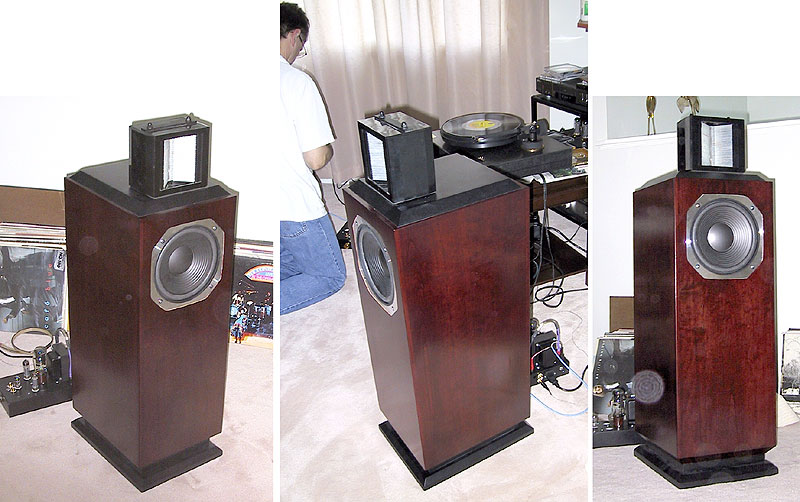The ESS AMT-1 is a beast of a high frequency transducer, being able to sound great crossed as low as 800hz. I'm sure members have taken advantage of this, and the super high sensitivity as well. I'd love to know which woofers you chose to use with the AMT-1.
I would also appreciate opinions on this mid woofer, for use with an AMT-1.
Celestion CF0820BMB - 8" Low frequency
And now, a buddy just asked me why I would not choose a 12" or a 15" for better dynamics, since it is only playing up to 800hz.
Thanks for any advice.
I would also appreciate opinions on this mid woofer, for use with an AMT-1.
Celestion CF0820BMB - 8" Low frequency
And now, a buddy just asked me why I would not choose a 12" or a 15" for better dynamics, since it is only playing up to 800hz.
Thanks for any advice.
A 12 or 15" woofer is going to be directional at your crossover point, while the AMT will have very wide dispersion (unless you're using a waveguide). For optimal imaging, it's typical to design for matched dispersion at the crossover point. How big a difference it makes and whether that's an important design aspect is up to you.
Also, some larger woofers aren't great at doing upper midrange. A lot of 12's have breakup regions in the 1-2 kHz area. A steeper crossover can help, but it's still worth careful examination when selecting drivers.
Also, some larger woofers aren't great at doing upper midrange. A lot of 12's have breakup regions in the 1-2 kHz area. A steeper crossover can help, but it's still worth careful examination when selecting drivers.
Thanks mattstat. Would anything change about what you said, if I were listening in a small room at 8ft away, with the speakers only 7 feet apart. Leaves only 1 ft to each side wall.
Sounds disgusting and disastrous! But in some lucky way, all speakers sound great in that room, and that set up. I listen seated in one spot only. Does these odd facts change anything? Thank you much
Sounds disgusting and disastrous! But in some lucky way, all speakers sound great in that room, and that set up. I listen seated in one spot only. Does these odd facts change anything? Thank you much
Regarding the listening room and distances, my guess is that being that close to side walls probably lessens the impact of more even power response on imaging, since reflections are happening close enough to the primary wave launch that they're more likely to merge with it. It could make crossover tuning a little fussy, but it pretty much always is if you are serious about it.
I wouldn't use uneven dispersion vs frequency on its own as a disqualifier. It's just a general design approach that's often viewed as desirable. You may have more important priorities or a room that makes it less relevant. You see well-reviewed products that aren't so great in this regard, so it's not like it's a strict deal breaker.
Though distortion is generally low with AMTs, it does increase with decreasing frequency. Depending on your listening levels, crossover slopes, and system goals that's something to keep an eye on also.
I wouldn't use uneven dispersion vs frequency on its own as a disqualifier. It's just a general design approach that's often viewed as desirable. You may have more important priorities or a room that makes it less relevant. You see well-reviewed products that aren't so great in this regard, so it's not like it's a strict deal breaker.
Though distortion is generally low with AMTs, it does increase with decreasing frequency. Depending on your listening levels, crossover slopes, and system goals that's something to keep an eye on also.
Last edited:
The ESS AMT-1 is a beast of a high frequency transducer, being able to sound great crossed as low as 800hz. I'm sure members have taken advantage of this, and the super high sensitivity as well. I'd love to know which woofers you chose to use with the AMT-1.
I would also appreciate opinions on this mid woofer, for use with an AMT-1.
Celestion CF0820BMB - 8" Low frequency
And now, a buddy just asked me why I would not choose a 12" or a 15" for better dynamics, since it is only playing up to 800hz.
Thanks for any advice.
It's been years since I've heard an actual ESS AMT speaker, but I always thought that they needed a midrange; there seemed to be an audible 'hole' between the 12" woofer and the tweeter (or whatever techy term they used for the ribbon unit)
I have had a couple of pairs of the ESS AMT's as well as their little brothers. The Big Heil doesn't sound good crossed at 800Hz. First, it's distortion is very high this low, any modern midrange driver has much lower distortion at 800Hz. Second, the off-axis response of the AMT is all over the place which makes it a difficult match. It has a typical dipole peak and dip around 1-1,5kHz and should only be used above that. Third, when you use it this low with a monopole woofer/midrange you are making a transition from monopole to dipole right in the most sensitive area of your hearing. This is less of an issue when crossed higher. Best sound I have heard out of them was a combination with a dipole mid/woofer on a wide baffle. Some of the off-axis irregularities are less of an issue when the AMT is mounted in a wide baffle. The Big Heil is kind of a double sided mismatched waveguide at best. Despite being a very nice high-frequency driver the original AMT-1 loudspeaker was a pretty bad design and sounded accordingly, don't bother copying it.
Since the Big Heil was only usable from 3 kHz on up IMHO I have abandoned them and went for some smaller ones which have the advantage of better vertical off-axis response. Nevertheless, it is possible to build a very nice sounding system with them as long as you can get around its deficiencies
Since the Big Heil was only usable from 3 kHz on up IMHO I have abandoned them and went for some smaller ones which have the advantage of better vertical off-axis response. Nevertheless, it is possible to build a very nice sounding system with them as long as you can get around its deficiencies
Now THIS is the kind of information I was hoping for! This should be archived for sure. We need first hand info like this. I've always read about being able to cross the AMT1 as low as 800hz ... sounds like a dream at first! Then we read this.
I hate so much to say it, but I'm coming to the conclusion the round AMT made by Heil for the Tempest was the giant killer of the bunch. It is monopole of course. It shouldn't really be crossed lower than 2400hz, and prefers 2700hz. But this particular AMT sounds more lifelike than Mundorfs or Arum Cantus do. Sound better than Scan 6400s or Hiquophons to my ears. Amazing for a 50 yr old tweeter!
I'm going to give up my original plans, and keep buying up the round Heil AMTs from Ebay. Thanks everyone.
I hate so much to say it, but I'm coming to the conclusion the round AMT made by Heil for the Tempest was the giant killer of the bunch. It is monopole of course. It shouldn't really be crossed lower than 2400hz, and prefers 2700hz. But this particular AMT sounds more lifelike than Mundorfs or Arum Cantus do. Sound better than Scan 6400s or Hiquophons to my ears. Amazing for a 50 yr old tweeter!
I'm going to give up my original plans, and keep buying up the round Heil AMTs from Ebay. Thanks everyone.
Yes, you are right here, the small Tempest tweeter is better than the Big Heil. It does not go as low and sounds a bit smaller but it has got a better top end, it has a more evenly off-axis response, horizontal and vertical. They do sound really good. They have a 3-4dB bump between 8kHz and 12Khz which makes it sound more upfront and dynamic but not in an annoying way. They do need first-class amplification though. If they tend to sound nasty check your amplification first they are very sensitive to it.
All in all, they are truly amazing for such old tweeters, not just good for there age but still up to par with any modern offering. The similar-sized Mundorf's are more refined though but not as dynamic. The Mundorfs are more 'HiFi' while the ess tempest sound more like a crossover between a ribbon and a compression driver. Which one is better depends on system synergy.
All in all, they are truly amazing for such old tweeters, not just good for there age but still up to par with any modern offering. The similar-sized Mundorf's are more refined though but not as dynamic. The Mundorfs are more 'HiFi' while the ess tempest sound more like a crossover between a ribbon and a compression driver. Which one is better depends on system synergy.
I have had a couple of pairs of the ESS AMT's as well as their little brothers. The Big Heil doesn't sound good crossed at 800Hz. First, it's distortion is very high this low, any modern midrange driver has much lower distortion at 800Hz. Second, the off-axis response of the AMT is all over the place which makes it a difficult match. It has a typical dipole peak and dip around 1-1,5kHz and should only be used above that. Third, when you use it this low with a monopole woofer/midrange you are making a transition from monopole to dipole right in the most sensitive area of your hearing. This is less of an issue when crossed higher. Best sound I have heard out of them was a combination with a dipole mid/woofer on a wide baffle. Some of the off-axis irregularities are less of an issue when the AMT is mounted in a wide baffle. The Big Heil is kind of a double sided mismatched waveguide at best. Despite being a very nice high-frequency driver the original AMT-1 loudspeaker was a pretty bad design and sounded accordingly, don't bother copying it.
Since the Big Heil was only usable from 3 kHz on up IMHO I have abandoned them and went for some smaller ones which have the advantage of better vertical off-axis response. Nevertheless, it is possible to build a very nice sounding system with them as long as you can get around its deficiencies
Rudy81 came out with an idea while Chris helps with DSP crossover of using two amt drivers stack them together vertically. This reduce the overall distortion and can lower the crossover point as low as 500Hz.
You can read more about it here and uses DSP crossover.
Double Stack ESS AMT-1 with Wings--Possible Kit for Heritage - Technical/Modifications - The Klipsch Audio Community
Buying two ESS AMT drivers is much cheaper.
There are 2 x 10”, one firing forward, one backward, wired in phase.
dave
what about inverted polarity wiring, each 10" in its own box?
regards
- Home
- Loudspeakers
- Planars & Exotics
- ESS AMT-1 two way designs

